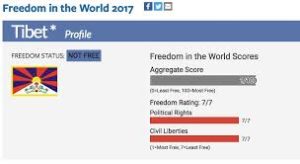China’s first national defense white paper since 2015 – China’s National Defense in the New Era– identifies separatism activities in Taiwan, Tibet, and Turkestan as serious threats to national security.
It is imperative that democracies like the United States remain strong supporters of Tibet, said His Holiness the Dalai Lama. For instance, the reincarnation issue solely rests with the Dala Lama HT: Human Rights in China].
 Change is always possible by combining digital communication tools with strategic nonviolent action to strengthen the capacity and effectiveness of the Tibet movement, argues Lhadon Tethong of the Tibet Action Institute (TAI). TAI’s team, comprised of technologists and human rights advocates, develops and advances open-source communication technologies, nonviolent strategies, and innovative training programs for Tibetans with a particular focus on digital security and harnessing the power of digital technologies, adds Tethong, a recipient of the National Endowment for Democracy’s 2019 award.
Change is always possible by combining digital communication tools with strategic nonviolent action to strengthen the capacity and effectiveness of the Tibet movement, argues Lhadon Tethong of the Tibet Action Institute (TAI). TAI’s team, comprised of technologists and human rights advocates, develops and advances open-source communication technologies, nonviolent strategies, and innovative training programs for Tibetans with a particular focus on digital security and harnessing the power of digital technologies, adds Tethong, a recipient of the National Endowment for Democracy’s 2019 award.
Since the Chinese Communist Party took power in 1949, the world has observed China’s brutal repression of religious and ethnic minorities. In the 60 years since the Dalai Lama was forced into exile, the Tibetan people have faced a systematic effort to destroy their culture, religion, and autonomy. More recently, reports have revealed the disturbing details of the China’s imprisonment of millions of Uyghurs from East Turkistan in modern-day concentration camps, where ordinary citizens are tortured and subject to relentless “assimilation” tactics, and outside the camps, the CCP has established an Orwellian police state.







